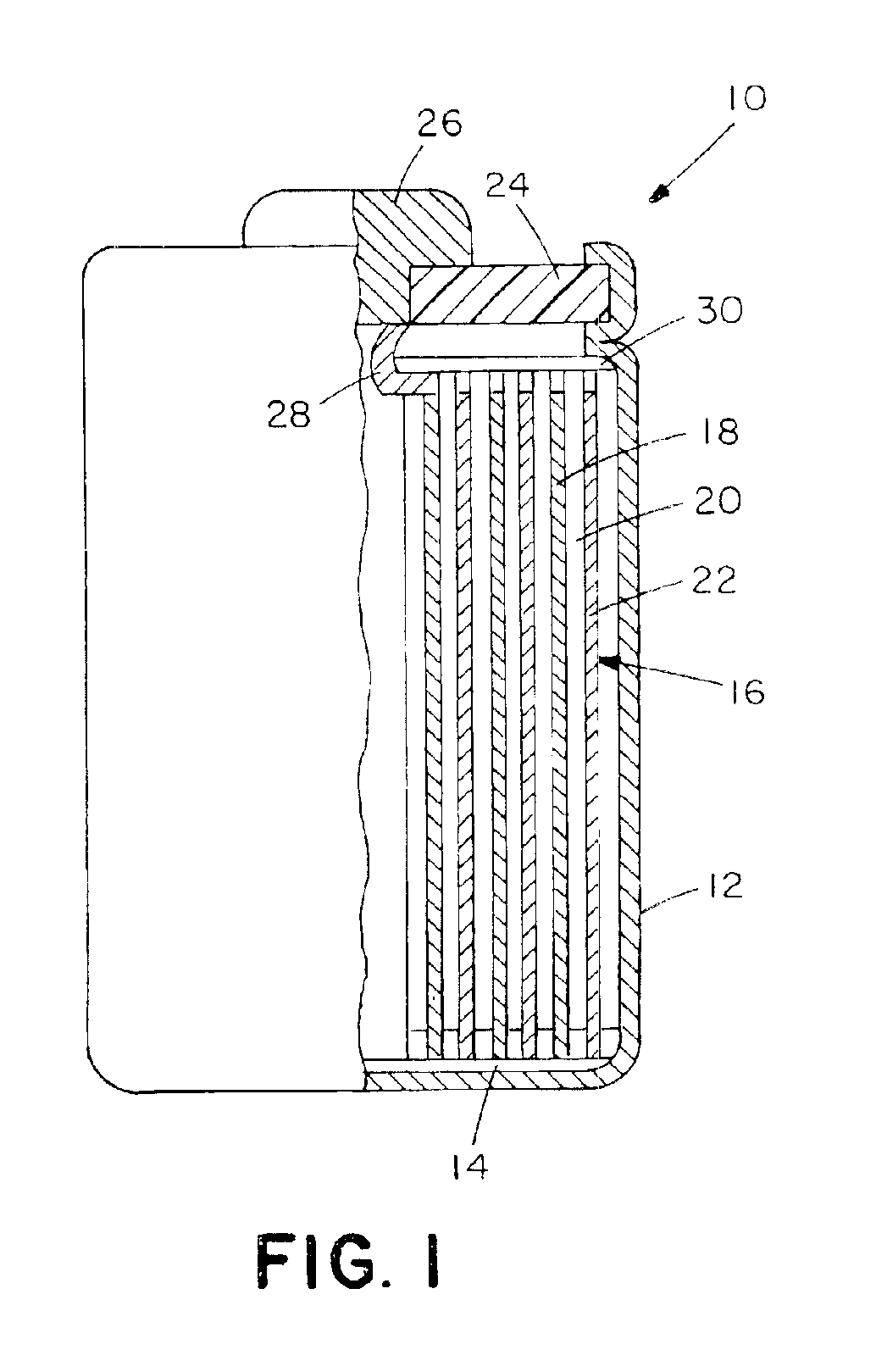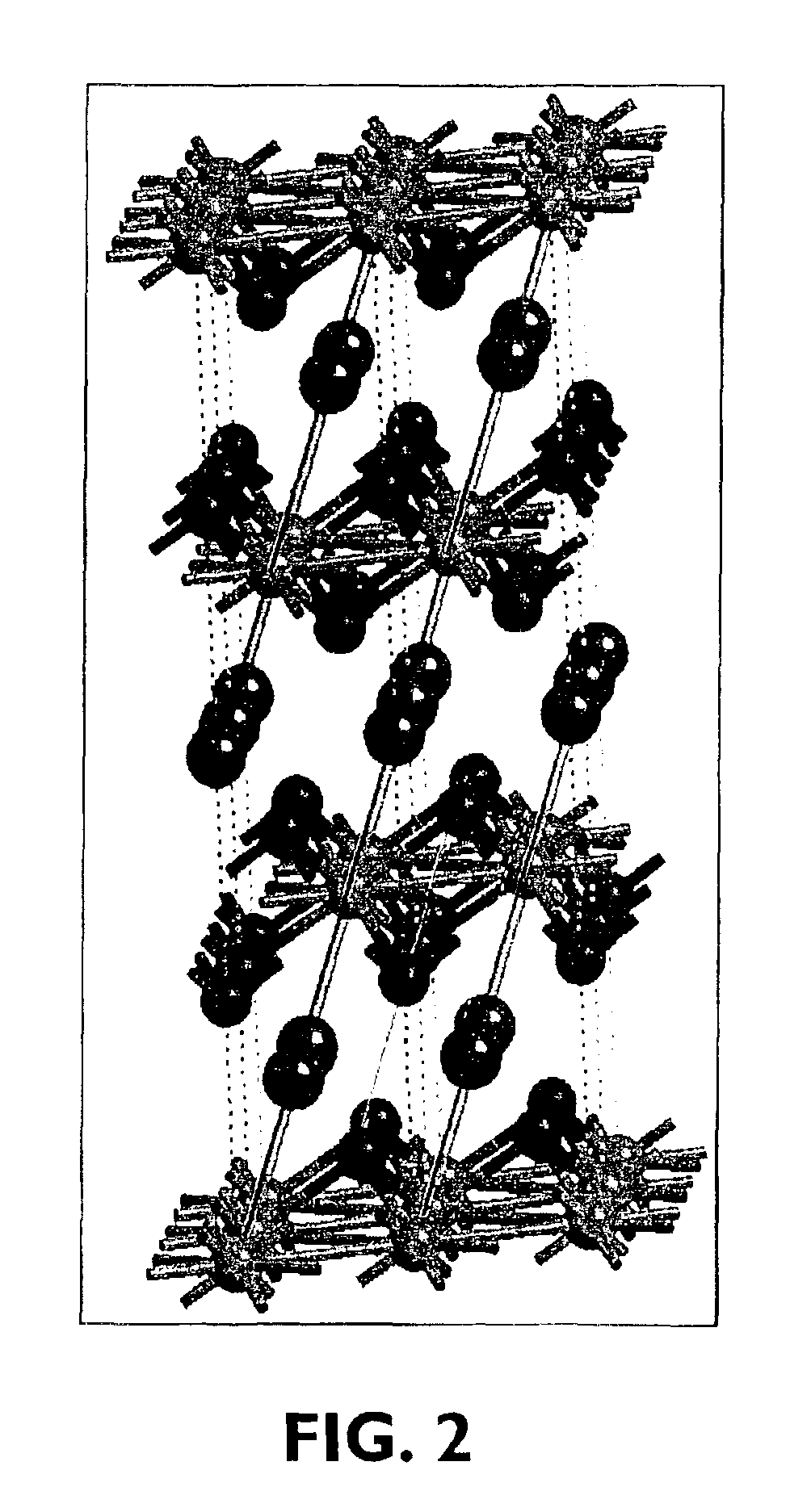Gradient cathode material for lithium rechargeable batteries
a lithium rechargeable battery and grade material technology, applied in the direction of secondary cell servicing/maintenance, cell components, nickel compounds, etc., can solve the problems of relatively low capacity, high cost of lithium battery cathodes, and general safety of liniosub>2/sub>-based materials, so as to improve the capacity, cyclability and safety of materials employed as cathodes, and improve the safety of materials. , the effect of improving the safety of materials
- Summary
- Abstract
- Description
- Claims
- Application Information
AI Technical Summary
Benefits of technology
Problems solved by technology
Method used
Image
Examples
example 1
Synthesis of 10% (mol / mol) LiCoO2 Gradient Having a LiNi0.8Co0.2O2 Core.
[0073]7.06 g LiNO3 and 29.69 g Co(NO3)2·6H2O were dissolved in 150 ml distilled H2O to which 100 g N-82 (LiNi0.6Co0.2O2) was added. The H2O was evaporated off on a hot plate during stirring. The obtained dried cake was ground for 5 minutes in the mortar grinder, placed in an alumina crucible, and sintered under the following heating profile: ramp 5° C. / minute to 450° C., hold at 450° C. for 1 hour, ramp 2° C. / minute to 750° C., and hold for 1 hour. The sample was then allowed to cool naturally to room temperature and ground for 5 minutes to break up agglomerates. When subjected to the XRD, this material shown to have a gradient profile. No impurities were visible, as can be seen in XRD pattern of FIG. 10. The lattice parameters were a=2.8676(6) A, c=14.168(2) A. Peak asymmetry by XRD was present in the sample FIG. 11.
[0074]Electrochemical measurements of this powder yielded a specific capacity of 172 mAh / g with ...
example 2
Synthesis of 2.5% (mol / mol) LiCoO2 Gradient Having a LiNi0.8Co0.2O2 (N-82, Nippon Chemical) Core.
[0075]1.77 g LiNO3, and 7.42 g Co(NO)3·6H2O were dissolved in 100 ml distilled H2O to which 100 g N-82 was added. The H2O was evaporated off on a hot plate during stirring. The obtained dried cake was ground for 5 minutes in the mortar grinder, placed in an alumina crucible, and sintered under the following heating profile: ramp 10° C. / minute to 110° C., hold at 110° C. for 20 minutes, ramp 5° C. / minute to 450° C., hold at 450° C. for 1 hour, ramp 2° C. / minute to 700° C., and hold for 1 hour. The sample then was allowed to cool naturally to room temperature and ground for 5 minutes to break up agglomerates. When subjected to XRD, this material was shown to have a gradient profile. No impurities were visible (FIG. 12). Peak asymmetry by XRD was present in the sample, FIG. 13.
[0076]Electrochemical measurements of this powder yielded a specific capacity of 148 mAh / g with a cycle efficiency ...
example 3
Synthesis of 10% (mol / mol) LiCoO2 Gradient Having a Li1.1Ni0.87Co0.1B0.03O2 (Arthur D. Little Material (ADL)) Core.
[0077]7.11 g LiNO3 and 29.98 g Co(NO)3·6H2O were dissolved in 150 ml distilled H2O to which 100 g Li1.1Ni0.87Co0.1B0.03O2 (ADL) was added. The H2O was evaporated off on a hot plate during stirring. The obtained dried cake was ground for 5 minutes in the mortar grinder, placed in an alumina crucible, and sintered under the following heating profile: ramp 5° C. / minute to 450° C., hold at 450° C. for 1 hour, ramp 2° C. / minute to 750° C., and hold for 1 hour. The sample then was allowed to cool naturally to room temperature and ground for 5 minutes to break up agglomerates. When subjected to XRD this material was shown to have a gradient profile. No impurities were visible (FIG. 14). The lattice parameters were a=2.873(2), b=c=14.167(5), and slight peak asymmetry by XRD was present in the sample, FIG. 15.
[0078]Electrochemical measurements of this powder yielded a specific c...
PUM
| Property | Measurement | Unit |
|---|---|---|
| temperature | aaaaa | aaaaa |
| temperature | aaaaa | aaaaa |
| temperature | aaaaa | aaaaa |
Abstract
Description
Claims
Application Information
 Login to View More
Login to View More - R&D
- Intellectual Property
- Life Sciences
- Materials
- Tech Scout
- Unparalleled Data Quality
- Higher Quality Content
- 60% Fewer Hallucinations
Browse by: Latest US Patents, China's latest patents, Technical Efficacy Thesaurus, Application Domain, Technology Topic, Popular Technical Reports.
© 2025 PatSnap. All rights reserved.Legal|Privacy policy|Modern Slavery Act Transparency Statement|Sitemap|About US| Contact US: help@patsnap.com



